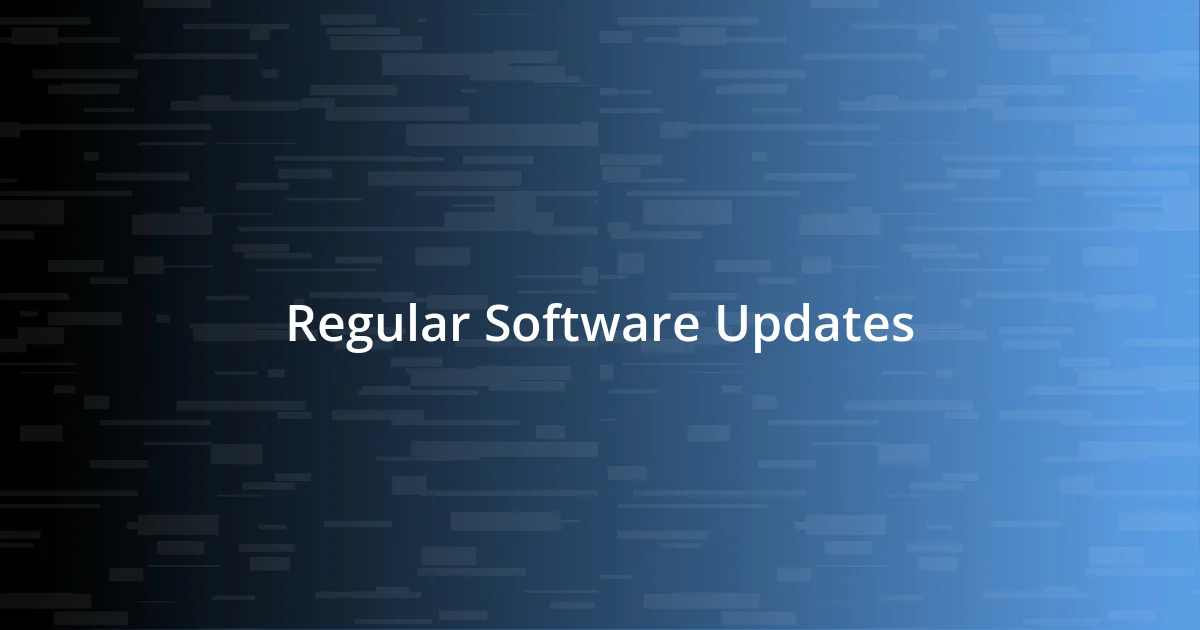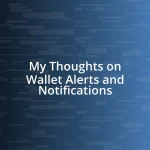Key takeaways:
- Wallet protection involves both physical safety and safeguarding personal information, requiring ongoing vigilance against theft and data breaches.
- Choosing a secure wallet with appropriate features, such as RFID-blocking or tracking capabilities, enhances protection against modern threats.
- Regular software updates, two-factor authentication, and informed awareness of emerging threats are crucial strategies for maintaining the security of digital wallets.

Understanding Wallet Protection
When I think about wallet protection, I often recall the time I misplaced my wallet at a coffee shop. The panic that ensued taught me how vulnerable I really was. Each card and dollar represented not just money, but my identity and peace of mind.
Understanding wallet protection isn’t just about securing your physical wallet; it’s about safeguarding your personal information. Have you ever considered how easily someone could access sensitive data with just a quick glance? This vulnerability can stem from everyday habits, like leaving your wallet unattended or sharing more information than necessary.
Moreover, wallet protection must adapt to new technologies and threats. I remember feeling uneasy when I first heard about RFID skimming, which felt like something out of a sci-fi movie. It made me realize that wallet security is an ongoing effort—not just a one-time action—and it requires vigilance in both physical and digital spaces.

Common Wallet Security Risks
Common wallet security risks can often surprise us with their simplicity and frequency. For instance, I once left my wallet on a public bench while I frantically searched for my phone. It was a moment of sheer panic, as a passerby could have easily taken it. This experience reinforced the need to stay vigilant in public spaces.
Here are some common risks to be aware of:
– Theft: Leaving your wallet unattended or in plain sight invites theft.
– Loss: Misplacing your wallet or not being mindful of where you place it increases the chance of losing it.
– Data Skimming: RFID-enabled cards can be easily skimmed by thieves using portable devices.
– Public Wi-Fi Risks: Accessing sensitive accounts through unsecured networks can lead to identity theft.
– Oversharing: Providing excessive personal information in conversations can lead to targeted attacks.
Even a small lapse in attention can have considerable consequences. It’s essential to blend awareness with small, proactive measures to keep our wallets safe.

Choosing a Secure Wallet
Choosing a secure wallet involves several critical considerations that can vary significantly based on your lifestyle. One time, while browsing in a quaint market, I nearly bought a wallet that was beautifully crafted but didn’t offer much in the way of security features. This experience highlighted to me that aesthetics shouldn’t overshadow durability and security—things like RFID protection should be non-negotiable for anyone who carries RFID-enabled cards.
Not all wallets are created equal, and understanding the features is essential. For instance, a hybrid wallet with both a physical and digital security aspect can provide an added layer of protection. I leaned toward a wallet that had a strong tracking feature, which once saved me from a harrowing situation when I left it at a friend’s house. Knowing I could locate my wallet through an app gave me peace of mind that I hadn’t experienced with my previous wallets.
When choosing a secure wallet, consider the materials and the design. Leather wallets have a classic charm, but if they’re not lined with protection against skimming, they can do more harm than good. On one occasion, I came across a wallet claiming to be “theft-proof.” I initially chuckled at the claim but later found it fascinating how manufacturers are now innovating rapidly to ensure security. This is a reminder to pay attention to product details to ensure your wallet choice balances both style and safety.
| Wallet Type | Security Features |
|---|---|
| Leather Wallet | Stylish, but often lacks RFID protection |
| RFID-Blocking Wallet | Designed specifically to prevent skimming |
| Smart Wallet | Includes tracking features and often connects to mobile apps |
| Textured Fabric Wallet | Usually lightweight, but check for built-in security |

Using Two-Factor Authentication
Utilizing two-factor authentication (2FA) can be a game changer when it comes to securing your digital wallet. I remember the first time I set up 2FA for my online banking account; it felt like an extra layer of armor around my finances. As soon as I received that second confirmation code, it drove home the point that even if someone had my password, gaining access would still be a challenge.
This added security is crucial, especially since we often rely on our phones for transactions. I once had a friend whose account was compromised because he overlooked enabling 2FA. It was heart-wrenching to see the stress it caused him, navigating the aftermath of identity theft. I often ask others—if an extra step can protect against such turmoil, why not take it?
Incorporating 2FA into your routine doesn’t have to be a chore. Whether it’s a text message, an app notification, or even a hardware key, these methods are straightforward to set up. Personally, I’ve found using an authentication app to be the most reliable. It takes just a few seconds, yet the peace of mind it provides is invaluable. Making that small investment in your security really does pay off in the long run.

Regular Software Updates
Regular software updates might seem mundane, but they play a pivotal role in keeping your wallet secure. I vividly remember the time I neglected an update on my digital wallet app. The next day, I noticed an unfamiliar transaction—what a wake-up call! That incident reinforced my belief that regular updates are like a security blanket; they patch vulnerabilities that could otherwise be exploited by attackers.
Whenever I see a prompt to update, I now jump on it without hesitation. Each update often includes bug fixes and security patches that developers release in response to newly discovered threats. Isn’t it fascinating how quickly the digital landscape evolves? I once read a statistic indicating that more than 60% of breaches occur due to outdated software. That’s a stark reminder of the risks involved in ignoring those familiar update alerts—it’s not just about new features; it’s about safeguarding my information.
In my experience, making updates a regular habit can shield you from potential crises. If someone asked me whether it’s worth taking those few moments to click “update,” my answer would be a resounding yes. I once made it a personal challenge to keep my apps updated weekly, and it dramatically reduced the stress I felt about potential security issues. I can’t help but wonder how many avoidable problems could pop up if we let those updates slide.

Backup and Recovery Strategies
One of the best strategies I’ve found for backup and recovery is creating regular backups of my wallet data. After experiencing a scare when my phone unexpectedly crashed, I learned the importance of having a recent backup. Since then, I’ve taken to backing up my wallet data every two weeks. In my view, it’s a small investment of time that pays off immeasurably if something goes wrong. Wouldn’t you agree that knowing your information is safe brings peace of mind?
Cloud storage has become my go-to method for backups. I remember a time when I lost access to my wallet because my device was stolen. The panic I felt was overwhelming! Fortunately, I had a cloud backup in place, which allowed me to restore everything quickly. It made me appreciate how seamless technology can be in this regard. If that’s not a testament to the power of cloud storage, I don’t know what is!
When it comes to recovery strategies, I highly recommend familiarizing yourself with your wallet’s recovery options. I once had an unsettling experience when I needed to restore my wallet after changing devices. The process felt daunting at first—I didn’t have my recovery phrase handy. Thankfully, after some frantic searching, I found it, and the relief was palpable. I can’t stress enough how crucial it is to keep that phrase stored in a safe place. Have you thought about how vulnerable you might be without that simple piece of information?

Staying Informed on Threats
Staying informed about emerging threats in the digital landscape is essential for wallet protection. I recall the moment I stumbled upon a news article that detailed a new phishing scam targeting digital wallet users. This eye-opener pushed me to research more about such scams and enabled me to spot suspicious emails that could have compromised my information. Have you ever received a message that seemed off? Knowing what to look for can make all the difference.
I think we can all agree that the internet is a constantly evolving creature. Just last year, I signed up for a cybersecurity newsletter, and it transformed my understanding of digital threats. Each update brought insights into new tactics cybercriminals were using, which often felt like uncharted territory. By staying abreast of these trends, I believe I’ve fortified my own defenses and made informed decisions about my wallet’s security.
Moreover, engaging with online forums and communities has proven invaluable. I’ve learned from others who share their experiences with security breaches or close calls. It’s reassuring to know that I’m not alone in navigating these challenges, and it’s also a reminder of the importance of vigilance. How often do you connect with others who prioritize security? Those shared stories and collective knowledge simply amplify our awareness of potential threats.












